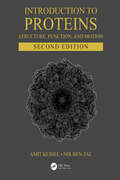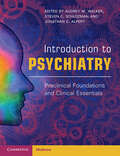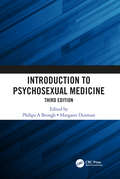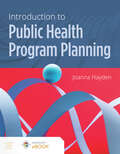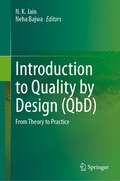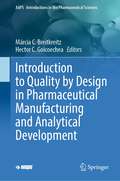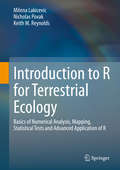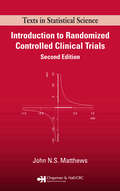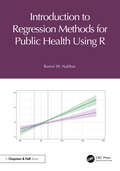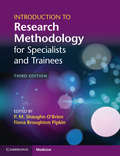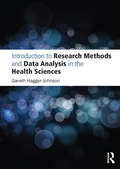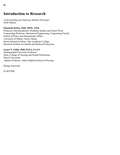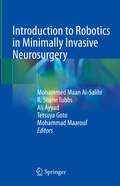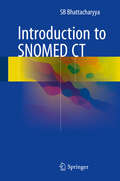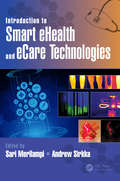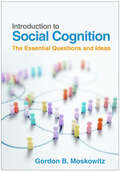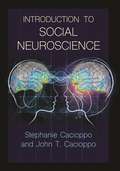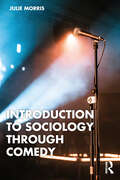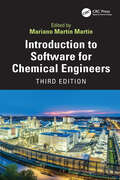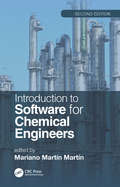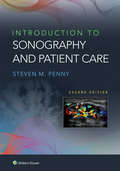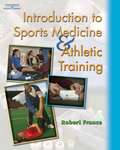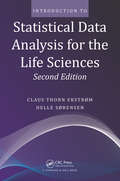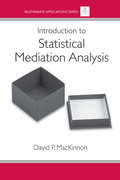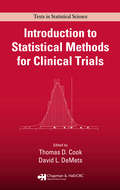- Table View
- List View
Introduction to Proteins: Structure, Function, and Motion, Second Edition (Chapman & Hall/CRC Computational Biology Series)
by Amit Kessel Nir Ben-TalIntroduction to Proteins provides a comprehensive and state-of-the-art introduction to the structure, function, and motion of proteins for students, faculty, and researchers at all levels. The book covers proteins and enzymes across a wide range of contexts and applications, including medical disorders, drugs, toxins, chemical warfare, and animal behavior. Each chapter includes a Summary, Exercises, and References.New features in the thoroughly-updated second edition include: A brand-new chapter on enzymatic catalysis, describing enzyme biochemistry, classification, kinetics, thermodynamics, mechanisms, and applications in medicine and other industries. These are accompanied by multiple animations of biochemical reactions and mechanisms, accessible via embedded QR codes (which can be viewed by smartphones) An in-depth discussion of G-protein-coupled receptors (GPCRs) A wider-scale description of biochemical and biophysical methods for studying proteins, including fully accessible internet-based resources, such as databases and algorithms Animations of protein dynamics and conformational changes, accessible via embedded QR codes Additional features Extensive discussion of the energetics of protein folding, stability and interactions A comprehensive view of membrane proteins, with emphasis on structure-function relationship Coverage of intrinsically unstructured proteins, providing a complete, realistic view of the proteome and its underlying functions Exploration of industrial applications of protein engineering and rational drug design Each chapter includes a Summary, Exercies, and References Approximately 300 color images Downloadable solutions manual available at www.crcpress.com For more information, including all presentations, tables, animations, and exercises, as well as a complete teaching course on proteins' structure and function, please visit the author's website.Praise for the first edition"This book captures, in a very accessible way, a growing body of literature on the structure, function and motion of proteins. This is a superb publication that would be very useful to undergraduates, graduate students, postdoctoral researchers, and instructors involved in structural biology or biophysics courses or in research on protein structure-function relationships." --David Sheehan, ChemBioChem, 2011"Introduction to Proteins is an excellent, state-of-the-art choice for students, faculty, or researchers needing a monograph on protein structure. This is an immensely informative, thoroughly researched, up-to-date text, with broad coverage and remarkable depth. Introduction to Proteins would provide an excellent basis for an upper-level or graduate course on protein structure, and a valuable addition to the libraries of professionals interested in this centrally important field." --Eric Martz, Biochemistry and Molecular Biology Education, 2012
Introduction to Psychiatry: Preclinical Foundations and Clinical Essentials
by Steven C. Schlozman Jonathan E. Alpert Audrey M. WalkerThe current global crisis in mental health has seen psychiatry assume an increasingly integral role in healthcare. This comprehensive and accessible textbook provides an evidence-based foundation in psychiatry for medical students and serves as an excellent refresher for all mental health professionals. Written by medical school faculty and experts in the field, with comprehensive coverage from neurobiology to population health, this essential textbook is an invaluable guide to the evaluation, treatment and current understanding of the major disorders in psychiatry. The book introduces the basics of clinical assessment and all major modalities of evidence based treatment, along with topics often not covered adequately in textbooks such as gender and sexuality, and global mental health. Chapters are complemented by easy to navigate tables, self-assessment questions, and a short bibliography of recommended reading. An essential resource for medical students, trainees, and other medical professionals seeking a clear and comprehensive introduction to psychiatry.
Introduction to Psychosexual Medicine: Third Edition
by Philipa A. Brough Margaret DenmanThis authoritative text for those training in Sexual Medicine now returns in a new edition that builds on what clinicians found most useful in the previous editions - physical and psychological background knowledge and all relevant treatments, combined with psychological therapies, principles, and case examples applied to common problems.
Introduction to Public Health Program Planning
by Joanna HaydenWritten to provide students with the essential program planning skills that they'll need in public health practice, Introduction to Public Health Program Planning offers an accessible and engaging approach to the program planning process. Divided into 3 parts, Introduction to Public Health Program Planning begins with an introduction to the basics of planning, health determinants, and behaviors. It then offers in-depth discussion of the generic planning phases - from assessing needs and planning to implementing and evaluation. The third section explores the four most commonly used planning frameworks, along with three additional planning frameworks that address specific health issues. A final chapter offers guidance on choosing a planning framework.
Introduction to Quality by Design (QbD): From Theory to Practice
by N. K. Jain Neha BajwaThis book offers a comprehensive exploration of the Quality by Design (QbD) methodology, guiding readers from theory to practical application with accessible examples. It equips readers with both foundational and advanced knowledge, emphasizing the critical parameters necessary for designing pharmaceutical products that meet the highest quality standards. The book goes beyond theory to demonstrate how to effectively implement QbD principles in various aspects of pharmaceutical research and development, including analytical methods, formulation, and packaging processes. Through a step-by-step approach, it prepares researchers in pharmaceutical sciences, as well as professionals in the pharmaceutical and healthcare industries (including suppliers), to successfully integrate QbD into their work.
Introduction to Quality by Design in Pharmaceutical Manufacturing and Analytical Development (AAPS Introductions in the Pharmaceutical Sciences #10)
by Márcia C. Breitkreitz Hector C. GoicoecheaWritten by twenty-five authors from academia, pharmaceutical industry and Pharmacopeias worldwide, this monograph covers the fundamentals and applications of Quality by Design (QbD) and Analytical Quality by Design (AQbD) in a practical and didactic manner. The book starts by describing the motivation and the urgent need for the implementation of the QbD framework in pharmaceutical development, along with the definition of its major elements: Quality Target Product Profile (QTTP), Critical Quality Attributes (CQAs), Critical Process Parameters (CPPs), Critical Material Attributes (CMAs) and the importance of using multivariate methods of Design of Experiments (DOE). The concept of life cycle and regulatory perspectives are discussed. Three chapters are entirely dedicated to DOE theory from screening to optimization designs. Moreover, a comprehensive discussion on modelling and data treatment is presented. Practical aspects of QbD and DOE for pharmaceutical product and process of different dosage forms is included, as well as a practical guide of the input process variables, material attributes, intermediate, and final quality attributes for the most representative pharmaceutical processes. Analytical Quality by Design (AQbD) is also deeply explored, including risk analysis, definitions of Analytical Target Profile (ATP), Method Operable Design Region (MODR) and the life cycle approach, taking into account the compendial and regulatory perspectives. A detailed example of a new chromatographic method for the quality control of a pharmaceutical topical product based on the AQbD procedure is shown. Finally, advanced statistical approaches and DOE methods for extraction studies of bioactive compounds are also presented. The vast amount of information offered in this book provides a comprehensive perspective on QbD, AQbD and DOE principles, essential tools for modern pharmaceutical and analytical development.
Introduction to R for Terrestrial Ecology: Basics of Numerical Analysis, Mapping, Statistical Tests and Advanced Application of R
by Keith M. Reynolds Milena Lakicevic Nicholas PovakThis textbook covers R data analysis related to environmental science, starting with basic examples and proceeding up to advanced applications of the R programming language. The main objective of the textbook is to serve as a guide for undergraduate students, who have no previous experience with R, but part of the textbook is dedicated to advanced R applications, and will also be useful for Masters and PhD students, and professionals. The textbook deals with solving specific programming tasks in R, and tasks are organized in terms of gradually increasing R proficiency, with examples getting more challenging as the chapters progress. The main competencies students will acquire from this textbook are: manipulating and processing data tablesperforming statistical testscreating maps in R This textbook will be useful in undergraduate and graduate courses in Advanced Landscape Ecology, Analysis of Ecological and Environmental Data, Ecological Modeling, Analytical Methods for Ecologists, Statistical Inference for Applied Research, Elements of Statistical Methods, Computational Ecology, Landscape Metrics and Spatial Statistics.
Introduction to Randomized Controlled Clinical Trials (Chapman & Hall/CRC Texts in Statistical Science)
by John N.S. MatthewsEvidence from randomized controlled clinical trials is widely accepted as the only sound basis for assessing the efficacy of new medical treatments. Statistical methods play a key role in all stages of these trials, including their justification, design, and analysis. This second edition of Introduction to Randomized Controlled Clinical Trials prov
Introduction to Regression Methods for Public Health Using R
by Ramzi W. NahhasIntroduction to Regression Methods for Public Health Using R teaches regression methods for continuous, binary, ordinal, and time-to-event outcomes using R as a tool. Regression is a useful tool for understanding the associations between an outcome and a set of explanatory variables, and regression methods are commonly used in many fields, including epidemiology, public health, and clinical research. The focus of this book is on understanding and fitting regression models, diagnosing model fit, and interpreting and writing up results. Examples are drawn from public health and clinical studies. Designed for students, researchers, and practitioners with a basic understanding of introductory statistics, this book teaches the basics of regression and how to implement regression methods using R, allowing the reader to enhance their understanding and begin to grasp new concepts and models.The text includes an overview of regression (Chapter 2); how to examine and summarize the data (Chapter 3), simple (Chapter 4) and multiple (Chapter 5) linear regression; binary, ordinal, and conditional logistic regression, and log-binomial regression (Chapter 6); Cox proportional hazards regression (survival analysis) (Chapter 7); handling data arising from a complex survey design (Chapter 8); and multiple imputation of missing data (Chapter 9). Each chapter closes with a comprehensive set of exercises.Key Features: Comprehensive coverage of the most commonly used regression methods, as well as how to use regression with complex survey data or missing data Accessible to those with only a first course in statistics Serves as a course textbook, as well as a reference for public health and clinical researchers seeking to learn regression and/or how to use R to do regression analyses Includes examples of how to diagnose the fit of a regression model Includes examples of how to summarize, visualize, table, and write up the results Includes R code to run the examples
Introduction to Research Methodology for Specialists and Trainees: For Specialists And Trainees
by Fiona O’brien P. m. Shaughn Broughton PipkinHealth-centred research has changed hugely over the last ten years, from the importance of computing software to the NHS becoming more involved in research. The expectations of grant-awarding bodies, ethics committees and publishers have evolved and increased in many senses. This new edition is designed for trainee clinicians, not only those preparing for membership of the Royal College of Obstetricians and Gynaecologists (MRCOG) but also higher degree candidates and aspiring clinical academics. Chapter authors with extensive expertise make the path to embarking on research direct, straightforward and most importantly, fun and interesting; particularly aiming to support those who trained clinically and are now undertaking a research project or beginning an academic career. There remains no single book with so much relevant information gathered in a single, succinct volume. This edition now covers the wide spectrum of modern research methods for all specialities, with five supplementary chapters on major obstetric and gynaecological subspecialties.
Introduction to Research Methods and Data Analysis in the Health Sciences
by Gareth Hagger-JohnsonWhilst the ‘health sciences’ are a broad and diverse area, and includes public health, primary care, health psychology, psychiatry and epidemiology, the research methods and data analysis skills required to analyse them are very similar. Moreover, the ability to appraise and conduct research is emphasised within the health sciences – and students are expected increasingly to do both. Introduction to Research Methods and Data Analysis in the Health Sciences presents a balanced blend of quantitative research methods, and the most widely used techniques for collecting and analysing data in the health sciences. Highly practical in nature, the book guides you, step-by-step, through the research process, and covers both the consumption and the production of research and data analysis. Divided into the three strands that run throughout quantitative health science research – critical numbers, critical appraisal of existing research, and conducting new research – this accessible textbook introduces: Descriptive statistics Measures of association for categorical and continuous outcomes Confounding, effect modification, mediation and causal inference Critical appraisal Searching the literature Randomised controlled trials Cohort studies Case-control studies Research ethics and data management Dissemination and publication Linear regression for continuous outcomes Logistic regression for categorical outcomes. A dedicated companion website offers additional teaching and learning resources for students and lecturers, including screenshots, R programming code, and extensive self-assessment material linked to the book’s exercises and activities. Clear and accessible with a comprehensive coverage to equip the reader with an understanding of the research process and the practical skills they need to collect and analyse data, it is essential reading for all undergraduate and postgraduate students in the health and medical sciences.
Introduction to Research: Understanding and Applying Multiple Strategies
by Laura N. Gitlin Elizabeth DePoyLearn the latest healthcare and human service research methods! <p><p>Introduction to Research: Understanding and Applying Multiple Strategies, 6th Edition helps bridge the gap between research and practice by giving you a solid foundation for critiquing your own work. This easy-to-read guide covers all the major research design strategies: qualitative, quantitative, naturalistic, experimental-type, and mixed method. Plus, the 6th edition has been updated to include contemporary references, an expanded discussion of big data, updated research methods, and more!
Introduction to Robotics in Minimally Invasive Neurosurgery
by R. Shane Tubbs Mohammed Maan Al-Salihi Ali Ayyad Tetsuya Goto Mohammad MaaroufThis book presents a basic introduction of the role of robotics in neurological surgery in a systematic organized manner. The work provides thorough explanations of the history, types, uses, application, current practice, and future directions of robotics in each division of the field of neurosurgery. The book is written in clear understandable language, making it suitable for medical students, interns, residents, specialists, consultants, and professors.
Introduction to SNOMED CT
by S. B. BhattacharyyaAs a general introduction to the SNOMED CT clinical terminology code system, the book explains in simple terms a wealth of key aspects, including the fundamentals of SNOMED CT, the various ways in which it can be used, and the methods by which it may quickly be deployed for use within an electronic documentation system that deals with clinical and clinics-related data. Further considerations include how end users can employ the system, how healthcare IT designers and developers can build highly ergonomic systems, and how health informatics experts and clinical analysts can successfully harness the various features that the clinical terminology code system provides in order to unleash the hidden potentials of clinical data. The book brings together material from various sources, presenting it in an easy-to-follow manner and supplemented by analyses of a number of different (imaginary) scenarios including case summaries from the author's experience and knowledge. The book will greatly benefit all stakeholders involved: clinicians, nurses, paramedics, dentists, public health professionals, health informatics professionals and healthcare IT engineers involved in the design and development of information systems for healthcare. Students at both the undergraduate and postgraduate levels seeking a practical introduction to SNOMED CT will find this book to be a valuable guide.
Introduction to Smart eHealth and eCare Technologies (Devices, Circuits, and Systems #63)
by Sari Merilampi Andrew SirkkaBoth the demographics and lack of resources in the health and well-being industry are increasingly forcing us to find alternative solutions for individualized health and social care. In an effort to address this issue, smart technologies present enormous potential in solving this challenge. This book strives to enhance communication and collaboration between technology and health and social care sectors. The reader will receive an extensive overview of the possibilities of various technologies in care sectors (including ICT, electronics, automation, and sensor technology) written by experts from various countries. <P><P>It will prove extremely useful for engineers developing well-being related systems, software, or other devices that can be used by professionals working with people with specialist needs, well-being and health service providers, educators teaching related courses, and upper level undergraduate students and graduate student studying related topics. The technology focus of the book is widespread and addresses elderly care and hospitals, in addition to solutions for various user groups, devices, and technologies. Beyond serving as a resource for nurses and people working in care sector, the book is also meant to give guidelines for engineers developing person-centered systems by exploring the integration of these technologies into service systems.
Introduction to Social Cognition: The Essential Questions and Ideas
by Gordon B. MoskowitzWhy are first impressions so powerful? How do we &“know&” what others are like when we cannot read their minds? How can scientists measure biases that people do not want to admit--or do not know they have? This engaging text delves into social cognition by exploring major questions in the field through an everyday lens. Students are introduced to core concepts and processes pertaining to how people come to know themselves and understand the behavior of others. Classic and contemporary findings and experimental methods are explained. The text connects the research to pressing contemporary problems--the roots of political polarization, why even rational people fall prey to misinformation, and the best ways to reduce prejudice. Boxed definitions of key terms are included throughout.
Introduction to Social Neuroscience
by John T. Cacioppo Stephanie CacioppoA textbook that lays down the foundational principles for understanding social neuroscienceHumans, like many other animals, are a highly social species. But how do our biological systems implement social behaviors, and how do these processes shape the brain and biology? Spanning multiple disciplines, Introduction to Social Neuroscience seeks to engage students and scholars alike in exploring the effects of the brain’s perceived connections with others. This wide-ranging textbook provides a quintessential foundation for comprehending the psychological, neural, hormonal, cellular, and genomic mechanisms underlying such varied social processes as loneliness, empathy, theory-of-mind, trust, and cooperation.Stephanie and John Cacioppo posit that our brain is our main social organ. They show how the same objective relationship can be perceived as friendly or threatening depending on the mental states of the individuals involved in that relationship. They present exercises and evidence-based findings readers can put into practice to better understand the neural roots of the social brain and the cognitive and health implications of a dysfunctional social brain. This textbook’s distinctive features include the integration of human and animal studies, clinical cases from medicine, multilevel analyses of topics from genes to societies, and a variety of methodologies.Unveiling new facets to the study of the social brain’s anatomy and function, Introduction to Social Neuroscience widens the scientific lens on human interaction in society.The first textbook on social neuroscience intended for advanced undergraduates and graduate studentsChapters address the psychological, neural, hormonal, cellular, and genomic mechanisms underlying the brain’s perceived connections with othersMaterials integrate human and animal studies, clinical cases, multilevel analyses, and multiple disciplines
Introduction to Sociology Through Comedy
by Julie MorrisQuestioning society and one’s place in it is a common theme in both comedy and sociology. Understanding and subverting hierarchies and norms, exploring deviance and taboos, and relating lived experience to broader questions all hold a crucial place for them both.Introduction to Sociology Through Comedy teaches foundational sociological concepts using comedy, first considering the history of sociology before employing examples from comedians – including standalone comedy bits, sketches, characters, and scenes – to illustrate a specific theory, concept, or social phenomenon. The profession of comedy is then used as a case study for the application of sociological concepts, such as impression management, social stratification, racial segregation, deviance, and stigma, allowing readers to gain familiarity with the concepts while simultaneously practicing their application.This book explains why we laugh by applying theories of humor, which will bolster students’ understanding of sociological principles by forcing them to question their own assumptions – helping them to put why they laugh into sociological terms.
Introduction to Software for Chemical Engineers
by Mariano Martín MartínThe field of chemical engineering and its link to computer science is in constant evolution, and engineers have an ever-growing variety of tools at their disposal to tackle everyday problems. Introduction to Software for Chemical Engineers, Third Edition provides a quick guide to the use of various computer packages for chemical engineering applications. It covers a range of software applications, including Excel and general mathematical packages such as MATLAB®, MathCAD, R, and Python. Coverage also extends to process simulators such as CHEMCAD, HYSYS, and Aspen; equation-based modeling languages such as gPROMS; optimization software such as GAMS, AIMS, and Julia; and specialized software like CFD or DEM codes. The different packages are introduced and applied to solve typical problems in fluid mechanics, heat and mass transfer, mass and energy balances, unit operations, reactor engineering, and process and equipment design and control.This new edition is updated throughout to reflect software updates and new packages. It emphasizes the addition of SimaPro due to the importance of life cycle assessment, as well as general statistics software, SPSS, and Minitab that readers can use to analyze lab data. The book also includes new chapters on flowsheeting drawing, process control, and LOOP Pro, as well as updates to include Pyomo as an optimization platform, reflecting current trends. The text offers a global idea of the capabilities of the software used in the chemical engineering field and provides examples for solving real-world problems.Written by leading experts, this handbook is a must-have reference for chemical engineers looking to grow in their careers through the use of new and improving computer software. Its user-friendly approach to simulation and optimization, as well as its example-based presentation of the software, makes it a perfect teaching tool for both undergraduate- and graduate-level readers.
Introduction to Software for Chemical Engineers, Second Edition
by Mariano Martín MartínThe field of Chemical Engineering and its link to computer science is in constant evolution and new engineers have a variety of tools at their disposal to tackle their everyday problems. Introduction to Software for Chemical Engineers, Second Edition provides a quick guide to the use of various computer packages for chemical engineering applications. It covers a range of software applications from Excel and general mathematical packages such as MATLAB and MathCAD to process simulators, CHEMCAD and ASPEN, equation-based modeling languages, gProms, optimization software such as GAMS and AIMS, and specialized software like CFD or DEM codes. The different packages are introduced and applied to solve typical problems in fluid mechanics, heat and mass transfer, mass and energy balances, unit operations, reactor engineering, process and equipment design and control. This new edition offers a wider view of packages including open source software such as R, Python and Julia. It also includes complete examples in ASPEN Plus, adds ANSYS Fluent to CFD codes, Lingo to the optimization packages, and discusses Engineering Equation Solver. It offers a global idea of the capabilities of the software used in the chemical engineering field and provides examples for solving real-world problems. Written by leading experts, this book is a must-have reference for chemical engineers looking to grow in their careers through the use of new and improving computer software. Its user-friendly approach to simulation and optimization as well as its example-based presentation of the software, makes it a perfect teaching tool for both undergraduate and master levels.
Introduction to Sonography and Patient Care
by Steven M. PennyMaster the sonography content and skills you need to prepare for, and succeed in, your specialized career! Introduction to Sonography and Patient Care, 2nd Edition, provides essential information and real-world applicable content, bridging the gap between didactic and clinical training. An easy-to-understand writing style and logically organized format take you step by step through each aspect of this dynamic, rewarding, and continually evolving imaging specialty.
Introduction to Sports Medicine and Athletic Training
by Robert C. FranceIntroduction to Sports Medicine & Athletic Training is a book written for individuals interested in athletics and the medical needs of athletes. This book is unique in that it covers four distinct disciplines in an easy to understand format. The four disciplines covered include: Sports Medicine, Athletic Training, Anatomy, and Physiology. This all-in-one resource allows the individual to grasp the concepts of anatomy and physiology, and then apply them to Sports Medicine and Athletic Training. Each discipline is fully presented, and uniquely sequenced together to give the user a full understanding of this exciting field. There are comprehensive chapters on nutrition and sports psychology. Instructors will enjoy the depth of the material covered and the ease in which it is presented. Introduction to Sports Medicine & Athletic Training is the first full-concept book ever written that an entire course can be created around.
Introduction to Statistical Data Analysis for the Life Sciences
by Claus Thorn Ekstrom Helle SørensenA Hands-On Approach to Teaching Introductory StatisticsExpanded with over 100 more pages, Introduction to Statistical Data Analysis for the Life Sciences, Second Edition presents the right balance of data examples, statistical theory, and computing to teach introductory statistics to students in the life sciences. This popular textbook covers the m
Introduction to Statistical Mediation Analysis (Multivariate Applications Ser.)
by David MacKinnonThis volume introduces the statistical, methodological, and conceptual aspects of mediation analysis. Applications from health, social, and developmental psychology, sociology, communication, exercise science, and epidemiology are emphasized throughout. Single-mediator, multilevel, and longitudinal models are reviewed. The author's goal is to help the reader apply mediation analysis to their own data and understand its limitations. Each chapter features an overview, numerous worked examples, a summary, and exercises (with answers to the odd numbered questions). The accompanying CD contains outputs described in the book from SAS, SPSS, LISREL, EQS, MPLUS, and CALIS, and a program to simulate the model. The notation used is consistent with existing literature on mediation in psychology. The book opens with a review of the types of research questions the mediation model addresses. Part II describes the estimation of mediation effects including assumptions, statistical tests, and the construction of confidence limits. Advanced models including mediation in path analysis, longitudinal models, multilevel data, categorical variables, and mediation in the context of moderation are then described. The book closes with a discussion of the limits of mediation analysis, additional approaches to identifying mediating variables, and future directions. Introduction to Statistical Mediation Analysis is intended for researchers and advanced students in health, social, clinical, and developmental psychology as well as communication, public health, nursing, epidemiology, and sociology. Some exposure to a graduate level research methods or statistics course is assumed. The overview of mediation analysis and the guidelines for conducting a mediation analysis will be appreciated by all readers.
Introduction to Statistical Methods for Clinical Trials (Chapman & Hall/CRC Texts in Statistical Science)
by Thomas D. Cook David L. DeMetsThis text provides a solid understanding of the various statistical topics relevant to the design, monitoring, and analysis of a clinical trial. It covers basic experimental design, sample size, randomization procedures, interim and survival analyses, quality of life assessment, and longitudinal methods. The book describes all phases of a clinical trial and explores the advantages of and objections to the intent-to-treat principle as well as its implementation. With exercises at the end of most chapters, it also illustrates methods using examples with real data from a variety of disease areas, including heart and lung diseases, cancer, and AIDS.
